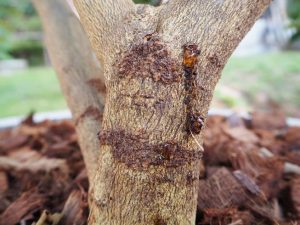Written by Bob Villa and published on https://www.bobvila.com/.
Because trees are so important to our everyday life (from buildings to paper), it is not surprising that we have a stronger connection to trees than almost every other plant. While the death of a flower may go unnoticed, a dying tree is something we find to be alarming and sad. The sad fact is that if you look at a tree and are forced to ask yourself, “What does a dying tree look like?”, chances are that tree is dying.
Table of Contents
7 Signs Your Tree is Dying—and How to Save It
A sick tree may be saved, but a dead tree can pose a risk your home and family. Look for these symptoms to determine the health of your tree.
Know the signs of a dying tree.
 Trees are valuable assets to a landscape. Not only do they provide aesthetics, but these towering plants also offer shade and shelter for wildlife and other plants. Sometimes a dying tree is obvious, with its leaves turning brown in the summer or branches riddled with holes from wood-boring pests. But it’s not always clear when trees are in poor health, which can make it difficult to address especially when a dead or dying tree located near a building or home. Broken limbs from a dying tree can cause injuries to people and pets and have the potential to lead to costly repairs if it lands on your home or car. Keep an eye out for these seven signs that you may have a dying tree so you can take care of it before it does damage to your property.
Trees are valuable assets to a landscape. Not only do they provide aesthetics, but these towering plants also offer shade and shelter for wildlife and other plants. Sometimes a dying tree is obvious, with its leaves turning brown in the summer or branches riddled with holes from wood-boring pests. But it’s not always clear when trees are in poor health, which can make it difficult to address especially when a dead or dying tree located near a building or home. Broken limbs from a dying tree can cause injuries to people and pets and have the potential to lead to costly repairs if it lands on your home or car. Keep an eye out for these seven signs that you may have a dying tree so you can take care of it before it does damage to your property.
1. The tree has brown and brittle bark or cracks.
As the tree is dying, the bark becomes loose and starts to fall off of a dying tree. The tree may also have vertical cracks or missing bark. “Check for deep splits in the bark that extend into the wood of the tree or internal or external cavities,” advises Matt Schaefer, the largest residential tree care company in North America and the first tree care company in the United States. Cracks often create weakness that can cause damage in storms or other weather events.
2. There are few healthy leaves left.
For deciduous trees, look for branches that lack lush green leaves and show only brown and brittle leaves during the growing season. They will also have dead leaves still clinging well into the winter instead of dropping to the ground. Coniferous evergreens will start to show red, brown or yellow needles or leaves when it’s stressed or dying.
3. The tree has an abundance of dead wood.
A couple of dead branches or dead wood doesn’t necessarily mean you have a dying tree. (Keeping a regular pruning schedule during the dormant season will keep your trees healthy and strong.) However, an increased prevalence of dead wood can indicate that it is a sick or dying tree. “Dead trees and branches can fall at any time,” Schaefer warns. This can potentially be a hazard to you and your home.
4. It’s a host to critters and fungus.
Pests such as bark beetles and carpenter ants live in trees that are under stress or are in the process of dying. These pests prefer to live in dead, weakened, or dying hosts. As for fungal or bacterial infections, look for cankers (discolored areas or depressed places on the bark) or mushrooms growing on the ground at the base of a tree or on the tree itself. These are indications of rot in the roots or trunk. “In time, decay will extend further within the tree leading to structural problems,” Schaefer says.
5. The tree shows signs of root damage.
Since roots run deep underground, determining damage isn’t always easily visible. If you’ve had recent excavation or construction projects near the tree, look out for any changes in the tree’s health since that time that might suggest the roots were damaged in the process. Likewise, if your tree has a shallow and/or partially exposed root system, pay attention to subtle changes that might suggest exposure to extreme elements and poor soil compaction have affected the vitality of the roots. Some signs of root damage include thinning foliage, poor yearly growth, yellow undersized leaves, dead branches, and wilted brown leaves during the growing season.
Original post here https://www.bobvila.com/slideshow/7-signs-your-tree-is-dying-and-how-to-save-it-53337#carpenter-ants-feeding-on-dying-tree.

